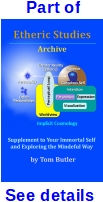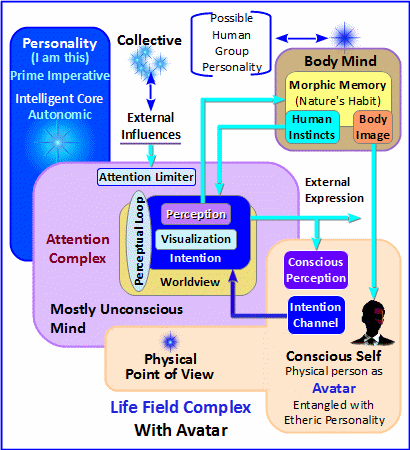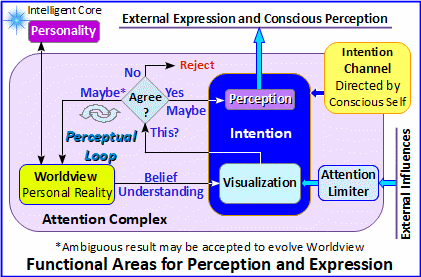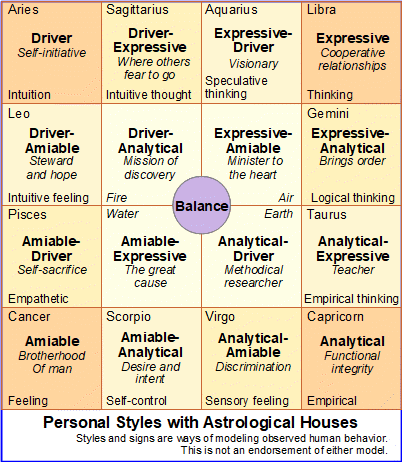Introduction
 “Point of view” is a person’s “I think the world looks like this” perspective.
“Point of view” is a person’s “I think the world looks like this” perspective.
This essay addresses point of view from the physical body or body-centric perspective. In this essay, a person is the conscious self as it is informed by its immortal personality, cultural education and human body instincts. This is the “I think I am this” we are accustomed to thinking of as who we are. In the Implicit Cosmology, the immortal personality is modeled as a person’s intelligent core representing the “I am this” perspective.
Point of view is portable in that a person’s sense of “I think I am this” may shift from the physical body during the waking state, to the dream state, meditative states and the occasional lucid awareness of perspective of the person’s personality.
Above all, it is important for people to know what they believe and why. This essay is intended to provide a sense of how we become who we are in terms of attitude about life, how beliefs affect a lifetime and how we might take charge of these very important influences.
The second aspect of this discussion concerns understanding the point of view of other people. Since organizations and communities tend to develop a collective personality, understanding point of view will also help understand how to relate to these entities.
Scope
This essay is also intended to address point of view from the perspective of the Implicit Cosmology. In that model, the etheric personality is who we really are as the immortal, intelligent core of a personality life field. It inhabits the nonphysical (etheric) aspect of reality and experiences the physical aspect of reality via its relationship with a physical body as its avatar. This relationship is shown in the Life Field Complex diagram below.

Models for reality
There are three well-established models or theories designed to explain who people are and their relationship to the world:
The Mainstream View of Who We Are
Given: There is only body
 It is reasonably safe to speculate that our physical body has evolved on this planet, and like other animals, it has evolved instincts intended to assure survival as a species. It has a hindbrain supporting body consciousness which assures the proper functioning of the body and manages its survival instincts. In this way, the body is a conscious life form that ceases to exist at death.
It is reasonably safe to speculate that our physical body has evolved on this planet, and like other animals, it has evolved instincts intended to assure survival as a species. It has a hindbrain supporting body consciousness which assures the proper functioning of the body and manages its survival instincts. In this way, the body is a conscious life form that ceases to exist at death.
Therefore: personality and body are one
 The mainstream view is that the mind is the product of the brain. The mind exists entirely within the brain and all functions of mind can be attributed to processes within the brain.
The mainstream view is that the mind is the product of the brain. The mind exists entirely within the brain and all functions of mind can be attributed to processes within the brain.
The Super-psi Hypothesis
Mind is independent of body and the psi field exists
 This is the same as the mainstream view with the exception that the Super-psi Hypothesis allows for mind-body duality and the existence of a psi field which permeates the entire physical universe. In this model, thought products of mind continue to exist after physical death. Each person is thought to be connected to the whole by this field, and through psi functioning, is able to sense it.
This is the same as the mainstream view with the exception that the Super-psi Hypothesis allows for mind-body duality and the existence of a psi field which permeates the entire physical universe. In this model, thought products of mind continue to exist after physical death. Each person is thought to be connected to the whole by this field, and through psi functioning, is able to sense it.
The Trans-survival Hypothesis
Personality is independent of the physical body
 This view requires that there is an aspect of reality that is not physical, which is referred to here as the etheric aspect of reality or the etheric. In this view the physical body is modeled as having evolved in the physical and is an avatar host for personality. See the Life Field Complex diagram above.
This view requires that there is an aspect of reality that is not physical, which is referred to here as the etheric aspect of reality or the etheric. In this view the physical body is modeled as having evolved in the physical and is an avatar host for personality. See the Life Field Complex diagram above.
Trans-survival Hypothesis versus the Survival HypothesisIt is important to note the distinction between the survival hypothesis referred to in parapsychology and the Trans-survival Hypothesis on which the Implicit Cosmology is based. Survival Hypothesis: Referred to in parapsychology as a contending theory to explain psi phenomena. The alternative theory most often referred to is the super-psi hypothesis. This version of the survival hypothesis is virtually always used in a general sense to say that mind and body are not the same; mind survives the body and is able to communicate across the veil. This is a “living personality” model while the Super-psi Hypothesis is a “memory of mind” model. Trans-survival Hypothesis: Transcommunication, especially Instrumental TransCommunication (ITC), has shown that the survival hypothesis referred to in parapsychology is essentially correct, but by incorporating implications of ITC, I have expanded the theory to such an extent that it would be a misrepresentation to suggest it is the same as referred to in parapsychology.
|
The “personality and body are independent” model best answers current evidence and is used throughout the Implicit Cosmology. Personality does not perceptually agree with the physical and requires the physical body in order to directly experience the physical. While the personality is associated with the physical body during a lifetime, personality’s point of view is from the perspective of looking out of the body’s eyes.
A person, which is a personality entangled with an avatar that experiences the world from a body-centric perspective, is influenced by the avatar’s instincts.
What are We Born With?
According to the Implicit Cosmology model, we came into this lifetime with the urge to gain understanding about the nature of reality through life experiences. Our personality has probably experienced many different venues for learning, and so, we come into this lifetime with a certain amount of acquired understanding which prepares us to better understand the nature of new experiences. In effect, we are born with a hunger to learn and a pre-existing attitude about what we will learn. This urge with an attitude guides us in life choices which might lead to beneficial or at least meaningful experiences and helps us make sense of them.
The essay on personality describes how the environment, body consciousness, worldview and experiences influence perception. Certainly while point of view is centered in the physical body, the ability of personality to influence behavior is very limited. As is illustrated in the Perception diagram below, the path of learning for personality is via the Perceptual Loop as it is limited by worldview.
Learning to manage the perceptual process is probably the most important tool available to a personality for managing personal progression.
Worldview
The Attention Complex in the Functional Areas for Perception diagram below is an unconscious process. It represents how environmental information is translated into conscious awareness. Note that the Perceptual Loop is moderated by worldview and functions as a filter that stands between a person’s “I think I am this” perspective of the conscious self and the “I am this” perspective of the person’s personality. What we think of sensed information is what emerges into our awareness after it is moderated by worldview. As such, worldview represents a person’s personal reality.
A person is born into this lifetime with a degree of understanding inherited from its collective and perhaps gained through prior experiences in other venues, and an urge to gain further understanding about the nature of reality. At birth, worldview is dominated by human avatar instincts.
Worldview is quickly populated with information happily provided by our parents, teachers, religious leaders and community. We are taught what is right according to our culture. We are not born with a moral guide, and therefore, might not have the presence of mind to recognize taught attitudes about other people as prejudice. Personality’s ability to influence worldview is also limited by the Perceptual Loop, meaning that cultural norms may be all we know.
As the perceptual process is modeled, if someone tells us something like “New York City is a great place to live,” the information is visualized and compared with worldview. We will likely relate that with how we currently live and how we would like to live. It is based on such an unconscious process that a reaction to the statement would emerge into our conscious awareness with “agree,” “ignore” it or perhaps an alternative view. Even more importantly, if the statement is reasonably close to what we previously believed, it will likely go toward modifying our worldview. Perhaps this would be “So and so thinks that….”
If worldview is thought of as a thoughtform which attempts to preserve the past but evolves with present influences, it can be seen that it is influenced by anything that is experienced by the person. However, worldview acts as a filter or control how the person perceives experiences, often filtering out information that contradicts worldview. This filtering effect is also a learned behavior of worldview and can be countered by what is often referred to as mindfulness or learning to consciously examine beliefs on a moment-to-moment basis.
Temperament
Since ancient times, observers of human behavior have noted that people tend to fit into personality types or styles of behavior that govern how they interact with the world. In 1981, David Merrill and Roger Reid published a book reporting their study of corporate personnel interactions which became something of an industry standard. They noted four main temperaments:
Analytical: Thinking, thorough, disciplined
Amiable: Supportive, patient, diplomatic
Driver: Independent, decisive, determined
Expressive: Good communicator, enthusiastic, imaginative

These temperaments are further divided so that one might be an Analytical-Driver or an Amiable-Expressive. Models like this help to predict how a person will react to a situation. Understanding the model and effectively identifying a client’s temperament might help a sales person make a more effective presentation. See the essay on Personality for more about Temperament.
Astrological Influences
Ignoring the idea of planetary influences, astrology is based on observed human behavior. The underlying assumption of astrology is that these are fixed at the time of birth, so that for instance, a Taurus is typically stubborn and an Aries is typically more aggressive than the average person.
The Personality Styles and Astrological Signs diagram above is my attempt to merge the four temperaments with the astrological signs. Two things to note is that signs are explained in terms that seem to be more directed toward the body’s instincts and styles are described in terms that seem to be directed toward personality. For instance, stubborn for Taurus is decidedly an instinct-driven behavior and Analytical-Expressive are decidedly characteristics of mindfulness.
Point of View as Influenced by Temperament
If we come into a lifetime with an urge to learn and a predisposition to prefer certain experiences, then the temperament models may be an indicator of the nature of that predisposition. Our worldview helps to shape attitudes, but that influence is moderated by our predisposition or temperament with which we were born.
For instance, a community may teach its citizens to be deeply afraid of demons, but if the temperament of a member of that society is to question fear, it may be natural for that person to turn that fearfulness into a curiosity as to why demons are fearful. Upon discovering there is nothing to fear, temperament might help to modify worldview’s influence permitting the person to be more accepting of the unknown.
So it is temperament or predisposition to select learning opportunities that determines point of view. In turn, being aware of point of view helps us to better understand who we are and why we do what we do. This in turn changes automatic reactions to situations into more deliberate responses to situations. We will experience and learn from those experiences without deliberate control, but being truly self-aware means knowing why. In that way, it is possible to align worldview with nature.
Villager-Explorer Effect
This is more commonly known as the sheep-goat effect, but I do not much like being called a sheep. In 1942, Professor Gertrude Schmeidler identified a correlation between people scoring high on a belief in the paranormal survey with their psi functioning scores. Conversely, a poor “belief” score correlated with a lower than chance psi function score. She referred to this as the “sheep-goat effect” with “believers” the sheep. As noted, for my self-esteem, I am referring to the “believers” as “explorers” because of their willingness to explore new ideas. Conversely, I am referring to disbelievers as “villagers” because of the more conservative attitude of people who live more by cultural norms and depend on maintaining the status quo.
This concept implies that people who allow for the possibility of new ideas are more able to experience new ideas. For instance, this can be seen in the concept of “incredulity blindness.” Suspended judgment, which is an acceptance of the possibility of etheric-physical interaction, offers far more opportunities for people who are open to them than those who are not. Conversely, how people relate to what they do experience is important in how they are able to incorporate the effects of this interaction into their lives. In short, people are more empowered by knowing that there is a greater reality.
Perceptual Agreement
Current understand of how people perceive reality is providing an explanation for the Villager-Explorer Effect. In First Sight Theory proposed by James Carpenter, perception begins as an unconscious process, from which only the results emerge into conscious awareness.
The Perception essay discusses how First Sight Theory is thought to provide the instruction set for the Perceptual Loop shown in the Perception diagram above. Perception is thought to be moderated by worldview and it is worldview that represents personal reality. If a person does not accept things paranormal, then information and expression involving things paranormal will be suppressed.
Engineer’s Imperative
At least in fields of study concerned with the physical sciences, there is a hierarchy of skill in which scientists expand knowledge, engineers apply knowledge and technicians implement plans. This is a generalization, but one which is of practical importance to this discussion.
In a particular subject or skill set, neither a scientist nor an engineer can be expected to have the practical expertise held by a journeyman technician. In frontier subjects, technician-level skills might be equivalent to practitioners. In frontier subjects, practitioners are often the most knowledgeable about the subject even though they may not be prepared to assess the paranormality of examples.
For the most part, an engineer holding a Bachelors of Science degree has been trained in the same subjects as has a person holding a doctorate. Doctorate programs are generally more detailed and include training in many task-related skills such as research design, data collection and analysis and research report writing.
Engineering curriculums are designed to introduce the physical concepts necessary to understand involved principles with emphasis on application. From personal experience, this means that an electronics engineer should be able to identify known physical principles that might be involved in an example.
Of course there are many life circumstances that help to determine how far a person progresses in college, but experience has shown that there is a substantial difference in point of view between people who choose to be an engineer and those who go on to earn a doctorate. Doctorates are trained to depend on precedence and guidance of existing theory while engineers are obliged to account for observed circumstances without regard to their theoretical nature.
Put in terms important to the study of frontier subjects, mainstream scientists are taught that everything must be defined or at least predicted by existing theory. If an observed incident is not covered by known principles, it is likely to be discounted as either an illusion or fraud. For instance, statistical outliers are routinely discarded during data analysis. This dismissive point of view is demonstrated over and over again in the struggle for “truth” between skeptics and experiencers in frontier subjects with skeptics saying, “It is impossible and therefore cannot be.”
This is difficult to characterize without over generalizing. The point is that people with an engineer’s point of view do not have the luxury of discounting phenomenal events just because they do not comply with known science. In this sense, there is something of an “engineering imperative” to account for the objective influences as well as the human factors constituting the circumstances of a design. If people experience it, then it must become a factor in the design.
In response to this imperative, the engineer’s approach to the study of frontier subjects can be expected to begin with the development of a hypothesis based on the assumption that the phenomena exists. In a practical sense, doctorates are not allowed to make that assumption. It is critical that people working on either side of the discussion remember that this difference in point of view is a huge hindrance to meaningful communication. In the spirit of Thomas Harris who told us in his book, I’m OK-You’re OK, that real communication between two people could only occur if both are in an “OK” place in life; communication can only occur if both sides agree that phenomena have occurred.
Point of View of Organizations
People have a point of view, but organizations are composed of a community of people. While personality typing (temperaments) is a way to model the point of view of people, a similar model might be used for organizations based on typical goals, objectives and assumptions. From the perspective of Etheric Studies, one might have:
Human psychology: Usually parapsychology; specifically an academic approach with emphasis on a physical-world perspective; emphasis on research; collaboration but guided by community norm.
Emergent science: Emphasis on academic approach; deliberate openness to new ideas; open to concepts of nonphysical and survived personality if they can be explained with mainstream science.
Human potential: Usually academic; open to nonphysical explanations; focus on personal growth and the human condition; supports research; education by opinion setters.
Social paranormal: Desire for scientific approach; for many, often first experience in paranormal; strong community; emphasis on nonphysical and survived personality; no formal collaboration; education by emergent cultural norm.
Metaphysical: Study/research of phenomena related to trans-etheric influence; desire for scientific approach; community emphasizing educational and application of principles; specifically open to nonphysical and survived personality.
Naturally, the Metaphysical point of view best suits the Association TransCommunication (ATransC); however, it is important to emphasize that this list of organizational points of view is conceived from the ATransC perspective. Other points of view may be appropriate for the representative organization’s goals, but it is important that people understand there are important differences between organizations based on mainstream thought and those allowing for possible postmortem survival.
Litmus Test
It is important for a person wishing to be involved in the study of transcommunication to compare the categorization of points of view for organizations involved in the study of things paranormal with the models of reality presented above. If the person’s point of view is that there is only physical reality, mind is a product of the brain and nothing survives physical death then the matching organizational point of view is human psychology and reported paranormal phenomena are due to mental aberrations.
If the person is open to new ideas such as survived personality but insists they must be explained in terms of mainstream science, emergent science organizations are the best choice.
If the person believes in the existence of a psi field connecting all living things and that people can deliberately interact with this field, the person will probably be more comfortable with the human potential groups. This is especially true if the person feels personality has evolved from the physical and that there really is no reality outside of the physical.
If the person just thinks paranormal phenomena are interesting and has no well-developed ideas beyond that, then the social paranormal groups can provide an important place to begin the discovery about things paranormal.
Finally, if the person feels that some part of loved ones survives bodily death and that they may be able to communicate with we who remain in the physical, then the metaphysical groups are almost the only resource.
Of course, a person can be in and participate in all of these groups. The important point here is that one should take time to examine personal point of view and what is expected of organizations the person intends to support. They should learn to recognize the perspectives authors have in their writing.
For instance, a parapsychologist will likely talk about mental mediumship (communion with discarnate people) from the perspective that the medium is unconsciously getting information from the sitter, or at most, somehow accessing information via some subtle field (Super-psi Hypothesis). In the same way, academically trained people in the more academic oriented organizations will be reluctance to give much credence to the opinion of people who are not academically trained (academic-layperson partition).
![]()
